
Most early information about large-scale floods in northwest Europe dates back to approx. 120 B.C. The hazard must have been so strong that coastlines were permanently altered and thousands of people died or were forced to migrate landwards. Centuries later, when written information became more common, death tolls and coastline changes were recorded in chronicles and captured in near-contemporary paintings.
In the region that is now the Netherlands, inundation happened many times: 1170, 1362, 1703, 1916, and 1953. The 13th century storm surge (1362), known as the "Great Drowning of Men" caused floods that swept across thousands of kilometers of coastline, breaking up islands, making parts of the mainland into islands, and exterminating entire towns and regions in England, Denmark, the Netherlands and Germany. Chronicles reported some 100.000 deaths.
Nevertheless, history provides not just a catalogue of catastrophes but also instructive lessons in human adaptability and preparedness. For instance, our coastal ancestors knew not to build too close to the water. If they did, they ensured that they could remove their houses quickly.
Despite such risks, living at the coast had economic and political benefits: Fishing, maritime trading, and fertility of coastal land together with political privileges such as autonomy in matters of civil jurisdiction contributed to the growth of coastal communities and towns in Europe.
